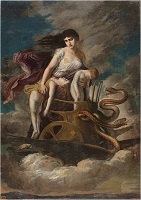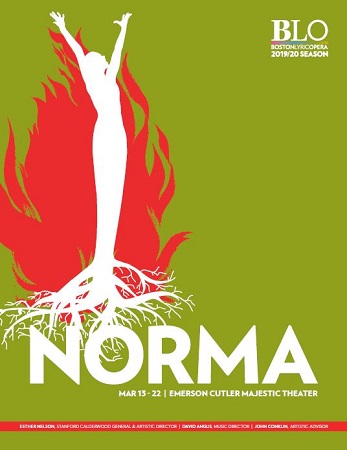Don’t have time to read through the whole guide? Here’s 5 Know-Before-You Listen facts to read before you listen to the Norma broadcast.
- What’s the plot? The Druid priestess Norma is in love with Pollione, a Roman leading the army occupying their land in Gaul. She finds out he has betrayed her for another virgin of her temple, Adaglisia. Having two kids with Pollione, Norma struggles with her loyalty to love or her land.

 Real or myth?: The story is set against the Gallic Wars, as the Roman’s sought to conquer more and more land around 50 B.C. The Druids were a real people who lived across Europe several different locations. Many Roman writers noted them in their writing, though we have little other historical evidence to understand them better. The libretto of Norma, is based in a French play contemporary to Bellini, but the story’s roots can be traced back all the way to the Greek myth of Medea and has been retold in many different iterations over the years.
Real or myth?: The story is set against the Gallic Wars, as the Roman’s sought to conquer more and more land around 50 B.C. The Druids were a real people who lived across Europe several different locations. Many Roman writers noted them in their writing, though we have little other historical evidence to understand them better. The libretto of Norma, is based in a French play contemporary to Bellini, but the story’s roots can be traced back all the way to the Greek myth of Medea and has been retold in many different iterations over the years.- So how did Bellini’s librettist know about the Druids to write Norma? Though this is only an audio recording, BLO’s production had set and costume designs that were inspired important Druid symbolism. What we know is that the Druids were basically social class within Celtic society. During the events of Norma, Romans were occupying Celtic land, forcing Druids to perform rituals in Roman-like temples rather than oak-tree forests. Despite the growing influence of the Romans which would eventually erase the culture, the Druids were exceptionally learned people, serving as priests and judges in Gallic society. Druidic women were active in war and politics unlike their Roman counterparts. As religion was tantamount to ancient societies, it was closely intertwined with other aspects of their culture. Their religion was nature-based. They prayed to Gods of rivers and fertility, had festivals around the seasons, and offer human sacrifices back to nature. Misteltoe, oak-trees, the moon, and other natural occurrences were important symbols to them. Medieval Irish Literature and 19th century English sources was interest was renewed in Celtic culture lead us offer the common image of the Druids in today’s mind – as magical, white bearded beings.

 What is bel canto and why should I care? A hallmark of Norma is that is has gone down in history as a shining example of bel canto singing. Translating to “beautiful singing”, it’s marked by long, smooth, melodic vocal lines, requiring extremely precise vocal technique, control of the vocal tone, fluid shifts between registers. Bel canto singers personalize their performance with ornamentations – improvisational, fast moving, and often high notes. This style of singing is very difficult and is a big reason Norma is so rarely performed due to the training and skill needed to do execute it.
What is bel canto and why should I care? A hallmark of Norma is that is has gone down in history as a shining example of bel canto singing. Translating to “beautiful singing”, it’s marked by long, smooth, melodic vocal lines, requiring extremely precise vocal technique, control of the vocal tone, fluid shifts between registers. Bel canto singers personalize their performance with ornamentations – improvisational, fast moving, and often high notes. This style of singing is very difficult and is a big reason Norma is so rarely performed due to the training and skill needed to do execute it. - Why should I not miss this livestream? As noted above, this show has been performed so rarely – 156 times in 125 years, compared to Verdi’s La Traviata which was produced 800 times just last year! When you listen, you’ll hear Norma’s power in her voice. Her role is unique to how female characters were traditionally written and viewed in the 19th century. Rather than the trope of a woman going (quite literally) mad for a man, Norma has autonomy as a leader, and the capacity to decide the fates of other characters This special role Her vocal and social power drew the best opera singers in history over the centuries – Maria Callas, Lili Sutherland, Joyce DiDonato, amongst other. Today’s rising star takes on Norma in BLO’s production – Elena Stikhina. (Interested in learning more about our artists? Check out our Program Book.


